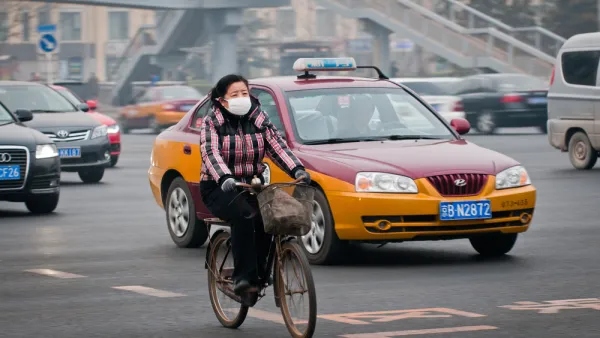Matthew Stevenson anticipates the end of the bicycle in China's major cities, now overrun with scooters and scrambling for Western status symbols – in spite of ever-worsening traffic.
In the midst of their near-overnight metamorphosis, cities in China are struggling to make sense of the tug-of-war between old and new ways of living. Increasingly, the experience of exploring these metropolises by bicycle is deeply emblematic of the older generation's losing battle.
Even just a few years ago, as Stevenson puts it, "Beijing was delightful by bike." But facing cultural pressures for status symbols and luxury, Chinese youth have lost their taste for the humble, utilitarian two-wheeler: "With a single gear and heavy steel frame, the [national standard model] is ideal for long rides on flat city streets. At a cost of US $180, it is the bike bargain of the world. Nevertheless, the dream for younger Chinese is a Honda scooter."
Riding a bicycle in Beijing still comes with certain privileges – dedicated lanes, exclusive rights-of-way, special parking spaces at train stations, and of course the convenience of being able to percolate through gridlocked traffic. But in an environment of ever more unenforceable traffic, cars and scooters encroach further and further on cyclists' territory, making cycling more nerve-wracking than delightful. Stevenson describes his observations during a recent tour through the capital:
"After a while, I had my eyes attuned to the demographics of bike riders. They tended to be school kids or the elderly. From this blacktop survey, I judged that middle-aged or prosperous Beijingers have little appetite for riding. Most were moving around on scooters, the kind that have clogged many Asian cities."
FULL STORY: The Beijing Bicycle: A Requiem

National Parks Layoffs Will Cause Communities to Lose Billions
Thousands of essential park workers were laid off this week, just before the busy spring break season.

Retro-silient?: America’s First “Eco-burb,” The Woodlands Turns 50
A master-planned community north of Houston offers lessons on green infrastructure and resilient design, but falls short of its founder’s lofty affordability and walkability goals.

Delivering for America Plan Will Downgrade Mail Service in at Least 49.5 Percent of Zip Codes
Republican and Democrat lawmakers criticize the plan for its disproportionate negative impact on rural communities.

Test News Post 1
This is a summary

Test News Headline 46
Test for the image on the front page.

Balancing Bombs and Butterflies: How the National Guard Protects a Rare Species
The National Guard at Fort Indiantown Gap uses GIS technology and land management strategies to balance military training with conservation efforts, ensuring the survival of the rare eastern regal fritillary butterfly.
Urban Design for Planners 1: Software Tools
This six-course series explores essential urban design concepts using open source software and equips planners with the tools they need to participate fully in the urban design process.
Planning for Universal Design
Learn the tools for implementing Universal Design in planning regulations.
EMC Planning Group, Inc.
Planetizen
Planetizen
Mpact (formerly Rail~Volution)
Great Falls Development Authority, Inc.
HUDs Office of Policy Development and Research
NYU Wagner Graduate School of Public Service





























